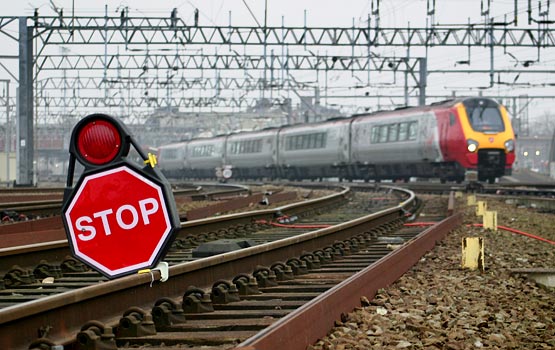|
Some indication of the shambles that underpins the management of on-track safety can be gleaned from the implementation of Network Rail’s updated Standard governing the ‘Safety of people working on or near the line’ (NR/L2/OHS/019 Issue 8). Well, I say ‘implementation’. Although it came into force as planned on 4th December, the deadline for compliance had to be extended by six weeks because contractors had not completed the necessary workforce briefings. And its first weekend saw a glut of jobs bite the dust due to ‘operational irregularities’. This was driven in part by a failure to train staff on extensive and substantive changes to the Rule Book. These weren’t even covered by a structured briefing programme. Instead a dry RSSB Powerpoint presentation of 91 slides and an associated booklet were issued, presumably as a cure for insomnia. Chances are, no-one was shown either.
Valueless bureaucracy is the foundation on which 019 is built and Issue 8 introduces two additional forms as reinforcement. We counted the tick-boxes last month so, this time, let’s turn our attention to the Rule Book. Traditionally regarded as the railwayman’s bible, it now has the reputation and gravitas of the Daily Sport thanks to the pig’s ear made of it successively by Railtrack’s Safety & Standards Directorate, then Railway Safety, and now RSSB.
|
| [The Rule Book] now has the reputation and gravitas of the Daily Sport... |
|
Under the latter’s "leadership" (their word, not mine), the Rule Book is undergoing another overhaul, referred to as the ‘New Approach’. This involves a programme to "systematically review and revise" all the existing modules to keep the Board’s many functionaries in highly-paid posts. The aim is to rationalise and restructure instructions in order to -
- reduce rule-based errors, violations and misapplication
- enable end-users to exercise greater judgement and discretion in resolving operational issues
- reduce the need for and the costs of future rules changes
- support industry goals for competence management and performance improvement.
All of these laudable goals did of course appear during the last Rule Book debacle in 2003, and look where that got us. The difference though is that, this time, the instructions have actually changed - quite significantly in many cases. This makes the absence of proper training particularly reckless.
The changes fall into three categories. Rules that passed their sell-by date years ago have finally been sent to landfill. Others have been declassified as ‘rules’ and transferred to lesser documents - such as local instructions - where they will languish, unseen and forgotten, until an inquiry chairman audits compliance with them. And some fall between two stools, existing only in the ether known as ‘training’ and not featuring in any end-user reference manual.
Replacing modules T7, T2 and T12 are a collection of five handbooks, numbered 6-10. Whilst abridged and pocket-sized, these don’t provide a coherent narrative and are singularly uninviting, relying almost exclusively on Plain (Pigeon) English text. Once again, little thought has been given to what the practitioner actually needs - one clear, concise, chronological and comprehensive guide explaining what is expected of him. You really have to question the culture and skillsets of those involved in this project.
In their totality, the changes found in the handbooks are too numerous to review here. But that 91-slide Powerpoint presentation can be downloaded by clicking here (323kB); there’s also the 40-page briefing leaflet (357kb). Contact details for the Samaritans are detailed on this page, but if it still proves too much, this website has products you might find helpful.
One fundamental shift sees the death of red and green zones…at least as far as the Rule Book is concerned. They remain central though to the new 019 Standard so those planners seeking advice on, for example, "separated green zones" now find themselves in a void. Like its seven associates, this term is now undefined. Also gone are the neat, tidy and well-understood labels "T12" and "T2". So a T2(D) becomes a “line blockage with additional protection provided by disconnecting signalling equipment”.
It’s worth cantering through a few of the most noteworthy or ridiculous edicts -
Handbook 6 - General duties of an IWA
- The rules gurus are clearly concerned about IWAs erecting scaffolding by themselves or using on-track plant!
Handbook 7 - General duties of a COSS
- The only activities that can be carried out by a group without blocking the line are -
- those taking place behind a fence/barrier
- those taking place at least 2m from the nearest line.
Standby for an end to maintenance thanks to the word "or" being errantly replaced by the more restrictive "and"!
- The word "planning" doesn’t make an appearance anywhere.
- Apparently, COSSs needs to understand what an "approaching train" is but an IWA does not. In any case, such twaddle constitutes ‘guidance’ and as such should be excluded from handbooks under the requirements of the 'New Approach'.
- The COSS is no longer instructed to make sure that each member of his workgroup is authorised to be on the railway and has a Sentinel card.
- Attaching a sign to a signal post is deemed to "affect the safety of the line" and requires a line blockage.
- You can work behind a rigid barrier just 1.25m (4 feet) from a 125mph line, with no warning of passing trains, despite the fact that you’re not in a position of safety at that distance.
- Requirements for the erection of temporary fences are no longer given.
- When working on an open uni-directional line, the need to ask the signaller whether Single Line Working is in operation is apparently not a rule any more.
- The restriction preventing the use of more than four distant/intermediate lookouts has been withdrawn.
- RSSB has "not been able to describe a safe procedure" for mobile workgroups and does not believe it is safe for "a lookout to be walking while carrying out their duties" or for sighting distances to be calculated when they "can change every few steps". This speaks volumes about the board’s inability to connect with the real world.

A list of the equipment that a lookout or site warden has to carry is no longer listed in the COSS's handbook, so he presumably doesn't have to check it.
Handbook 8 - Blocking a line
The old T12/T2 arrangements have been decimated, with many instructions about the detailed implementation of ‘additional protection’ removed. Moreover -
- A PC cannot provide verbal authority for a COSS/IWA to share their T2 in the same way that a PICOP allows an ES to set up a worksite within his T3. The PC’s form has to be signed, thus impacting significantly on productivity and rendering such arrangements impractical in many cases.
- For the procedure formerly known as a T12, the one-hour time limit and maximum workgroup size of six people have been removed.
- The signaller, rather than the COSS/IWA, is now responsible for arranging disconnections and reconnections for the procedure formerly known as a T2(D).
- The red flag/light in the four-foot at the site of work - effectively, a piece of string supplementing the belt and the brace - has been pointlessly retained.
- A stabled train on a platform line can no longer be used as a TCOD unless authorised in local instructions.
- There no longer has to be "adequate means of communication" between the COSS/IWA and signaller, or for communications to be checked. "A competent person should do this naturally" according to RSSB.
- The signaller is now not informed if the COSS/PC who arranged a line blockage is relieved before it is given up. Standby to be awoken at home.
- The procedure formerly known as a T2(H) can no longer be taken using site and distant handsignallers, by arranging for a handsignaller to fall asleep in the signal box, or for a handsignaller to display a red flag at the protecting signal. It’s a PLB and dets only.

You have to applaud RSSB for finally accepting that its modular Rule Book simply wasn’t fit for purpose. Something had to be done; money, time and effort have consequently been invested. Unfortunately, even with support from outside its own ranks, the organisation evidently doesn’t have the expertise to deliver the effective Rule Book that’s needed. It ought to be the definitive repository for all relevant instructions, not just those selected by a rack of suits with questionable competence. Get rid of rules by all means, but hiding them away in documents unseen by end-users is a nonsense. Hoping people will do things "naturally" is even more absurd. And where does a COSS go to gen-up on a procedure communicated only on his initial course five years ago? The need is not for a Rule Book that’s as brief as possible; what’s required is one that’s appropriate and understandable.
Beyond those failings, the industry’s inability to successfully handle the new handbooks’ introduction through a proper training programme has left practitioners hopelessly unprepared for the challenges they bring. The clue is in the Powerpoint presentation - 91 slides-worth of amendments but no formal tuition. On what planet does that stack up?
As ever, deficient management has pushed on-track safety back five paces when the opportunity was there for it to take a step forward.
Story added 1st January 2011
|